Abstract
Muscle fibre number and cross sectional area were studied in the response to immobilisation atrophy of the long head of the triceps brachii. Following eight weeks of immobilisation, fibre number of the muscle from the immobilised limb was compared to that of the contralateral control limb in six rats. Mean fibre cross sectional area of the LHT from the immobilised limb was compared to that of the contralateral control for another six animals. Atrophy, as estimated by a decrease in wet muscle weight, was 38.0% for the group used for fibre number estimations and 45.7% for the group used for fibre area. Fibre counts revealed no difference between muscles from immobilised and control limbs. Mean fibre area was 42.1% less for the muscle from the immobilised limb compared to the control limb. The results of this study indicate that atrophy of the LHT produced by immobilisation of the forelimb is the result of atrophy of the muscle fibres without a decrease in muscle fibre number.
Full text
PDF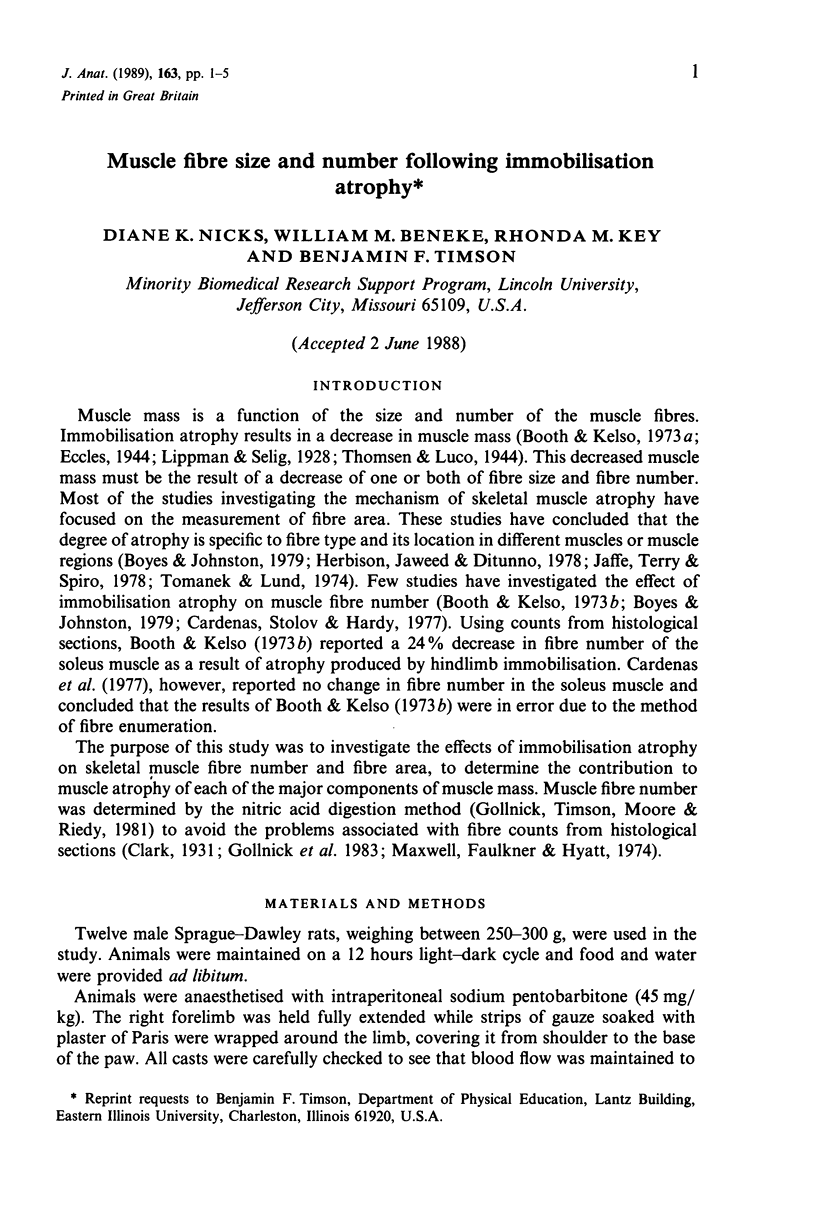
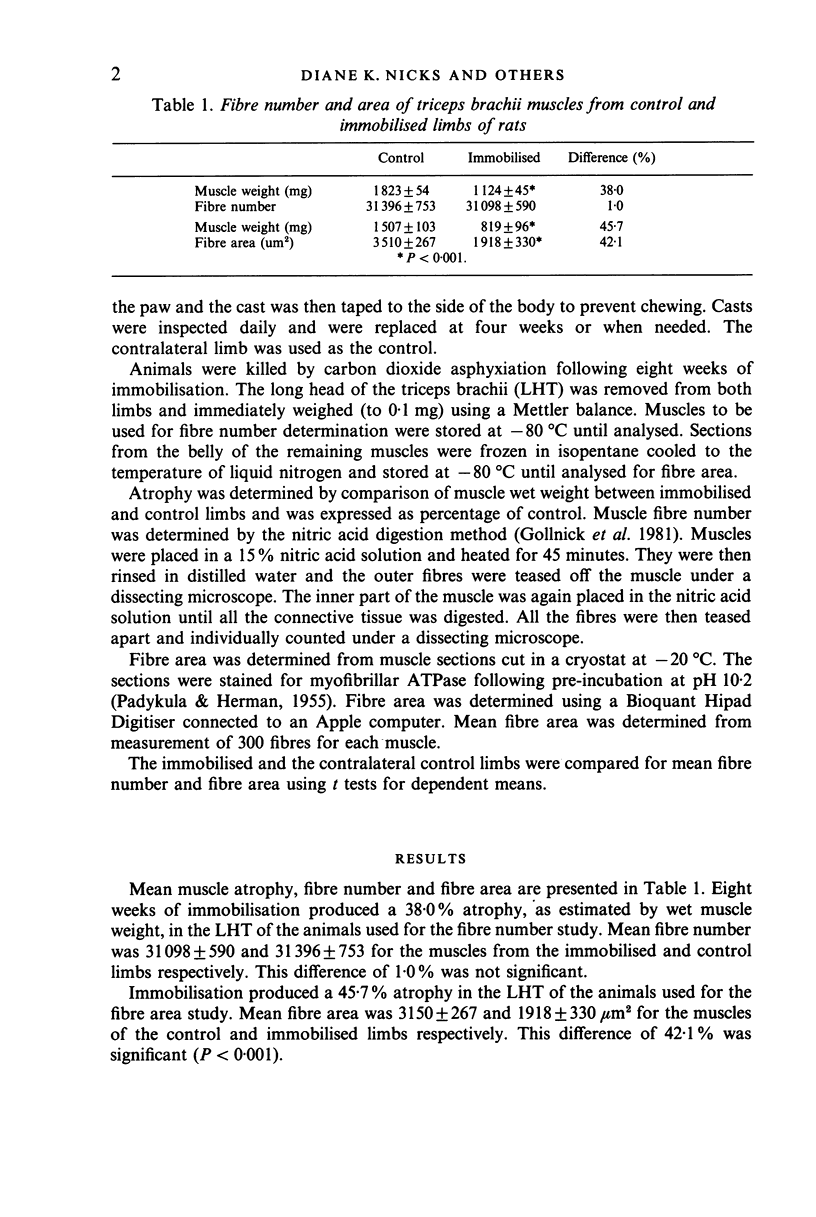
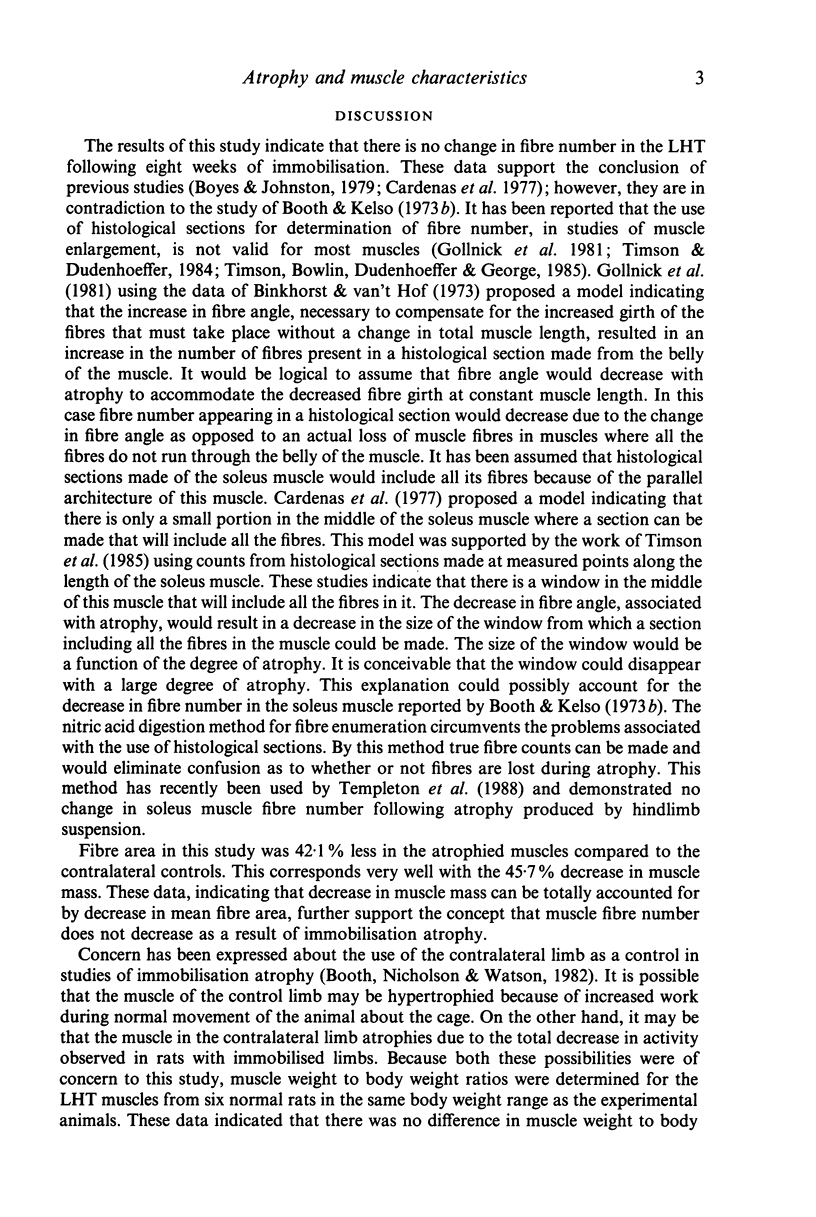
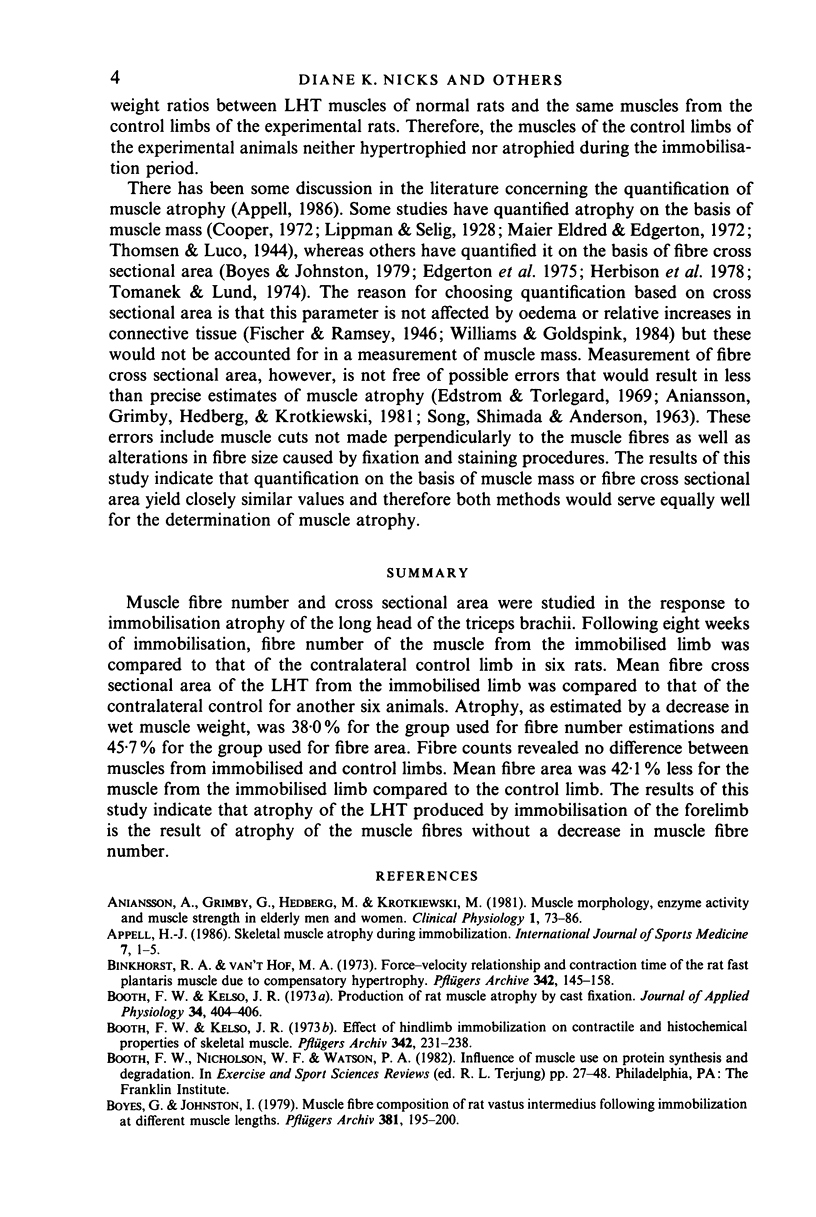
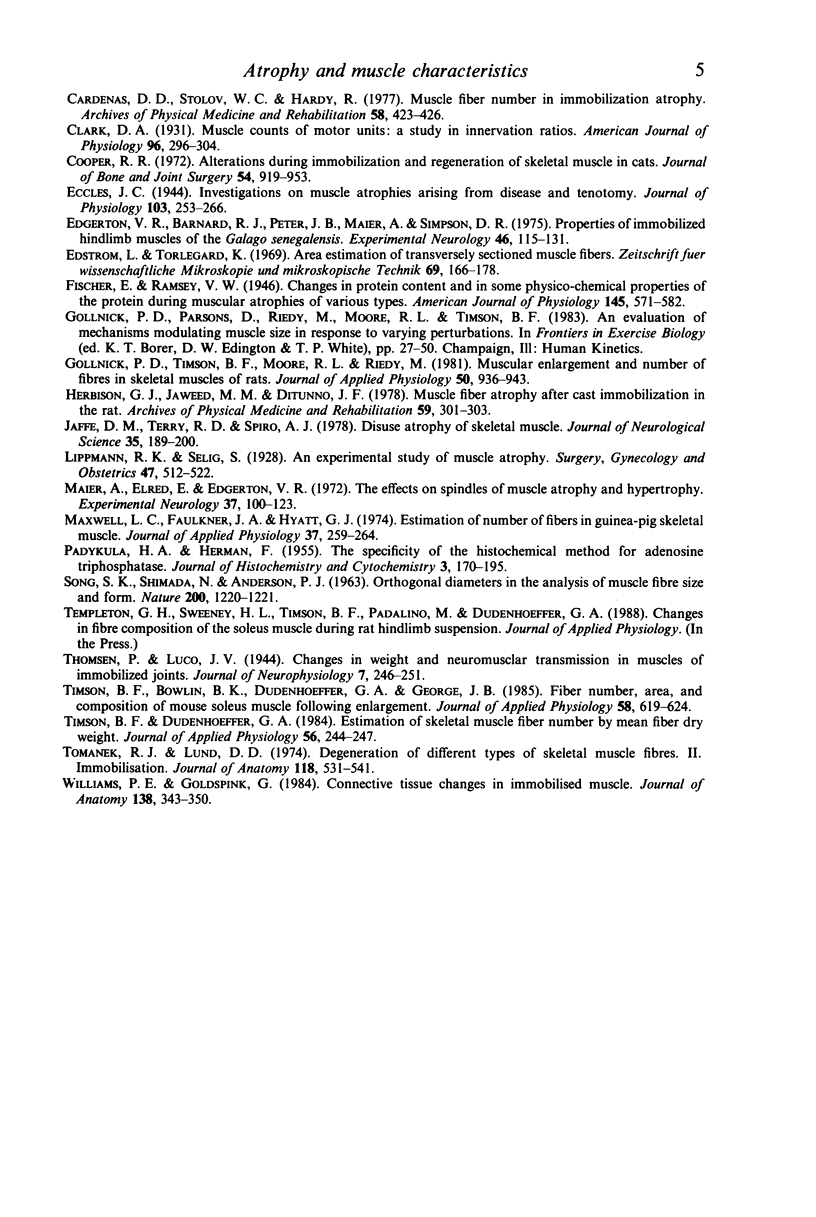
Selected References
These references are in PubMed. This may not be the complete list of references from this article.
- Appell H. J. Skeletal muscle atrophy during immobilization. Int J Sports Med. 1986 Feb;7(1):1–5. doi: 10.1055/s-2008-1025725. [DOI] [PubMed] [Google Scholar]
- Binkhorst R. A., 't Hof MA van Force-velocity relationship and contraction time of the rat fast plantaris muscle due to compensatory hypertrophy. Pflugers Arch. 1973 Aug 17;342(2):145–158. doi: 10.1007/BF00587845. [DOI] [PubMed] [Google Scholar]
- Booth F. W., Kelso J. R. Effect of hind-limb immobilization on contractile and histochemical properties of skeletal muscle. Pflugers Arch. 1973 Aug 27;342(3):231–238. doi: 10.1007/BF00591371. [DOI] [PubMed] [Google Scholar]
- Booth F. W., Kelso J. R. Production of rat muscle atrophy by cast fixation. J Appl Physiol. 1973 Mar;34(3):404–406. doi: 10.1152/jappl.1973.34.3.404. [DOI] [PubMed] [Google Scholar]
- Booth F. W., Nicholson W. F., Watson P. A. Influence of muscle use on protein synthesis and degradation. Exerc Sport Sci Rev. 1982;10:27–48. [PubMed] [Google Scholar]
- Boyes G., Johnston I. Muscle fibre composition of rat vastus intermedius following immobilisation at different muscle lengths. Pflugers Arch. 1979 Sep;381(3):195–200. doi: 10.1007/BF00583249. [DOI] [PubMed] [Google Scholar]
- Cardenas D. D., Stolov W. C., Hardy R. Muscle fiber number in immobilization atrophy. Arch Phys Med Rehabil. 1977 Oct;58(10):423–426. [PubMed] [Google Scholar]
- Eccles J. C. Investigations on muscle atrophies arising from disuse and tenotomy. J Physiol. 1944 Dec 15;103(3):253–266. doi: 10.1113/jphysiol.1944.sp004074. [DOI] [PMC free article] [PubMed] [Google Scholar]
- Edgerton V. R., Barnard R. J., Peter J. B., Maier P. A., Simpson D. R. Properties of immobilized hind-limb muscles of the Galago senegalensis. Exp Neurol. 1975 Jan;46(1):115–131. doi: 10.1016/0014-4886(75)90036-9. [DOI] [PubMed] [Google Scholar]
- Edström L., Torlegard K. Area estimation of transversely sectioned muscle fibres. Z Wiss Mikrosk. 1969 Jun;69(3):166–178. [PubMed] [Google Scholar]
- Gollnick P. D., Timson B. F., Moore R. L., Riedy M. Muscular enlargement and number of fibers in skeletal muscles of rats. J Appl Physiol Respir Environ Exerc Physiol. 1981 May;50(5):936–943. doi: 10.1152/jappl.1981.50.5.936. [DOI] [PubMed] [Google Scholar]
- Herbison G. J., Jaweed M. M., Ditunno J. F. Muscle fiber atrophy after cast immobilization in the rat. Arch Phys Med Rehabil. 1978 Jul;59(7):301–305. [PubMed] [Google Scholar]
- Jaffe D. M., Terry R. D., Spiro A. J. Disuse atrophy of skeletal muscle. A morphometric study using image analysis. J Neurol Sci. 1978 Feb;35(2-3):189–200. doi: 10.1016/0022-510x(78)90002-3. [DOI] [PubMed] [Google Scholar]
- Maier A., Eldred E., Edgerton V. R. The effects on spindles of muscle atrophy and hypertrophy. Exp Neurol. 1972 Oct;37(1):100–123. doi: 10.1016/0014-4886(72)90229-4. [DOI] [PubMed] [Google Scholar]
- Maxwell L. C., Faulkner J. A., Hyatt G. J. Estimation of number of fibers in guinea pig skeletal muscles. J Appl Physiol. 1974 Aug;37(2):259–264. doi: 10.1152/jappl.1974.37.2.259. [DOI] [PubMed] [Google Scholar]
- PADYKULA H. A., HERMAN E. The specificity of the histochemical method for adenosine triphosphatase. J Histochem Cytochem. 1955 May;3(3):170–195. doi: 10.1177/3.3.170. [DOI] [PubMed] [Google Scholar]
- SONG S. K., SHIMADA N., ANDERSON P. J. ORTHOGONAL DIAMETERS IN THE ANALYSIS OF MUSCLE FIBRE SIZE AND FORM. Nature. 1963 Dec 21;200:1220–1221. doi: 10.1038/2001220a0. [DOI] [PubMed] [Google Scholar]
- Timson B. F., Bowlin B. K., Dudenhoeffer G. A., George J. B. Fiber number, area, and composition of mouse soleus muscle following enlargement. J Appl Physiol (1985) 1985 Feb;58(2):619–624. doi: 10.1152/jappl.1985.58.2.619. [DOI] [PubMed] [Google Scholar]
- Timson B. F., Dudenhoeffer G. A. Estimation of skeletal muscle fiber number by mean fiber dry weight. J Appl Physiol Respir Environ Exerc Physiol. 1984 Jan;56(1):244–247. doi: 10.1152/jappl.1984.56.1.244. [DOI] [PubMed] [Google Scholar]
- Tomanek R. J., Lund D. D. Degeneration of different types of skeletal muscle fibres. II. Immobilization. J Anat. 1974 Dec;118(Pt 3):531–541. [PMC free article] [PubMed] [Google Scholar]
- Williams P. E., Goldspink G. Connective tissue changes in immobilised muscle. J Anat. 1984 Mar;138(Pt 2):343–350. [PMC free article] [PubMed] [Google Scholar]


